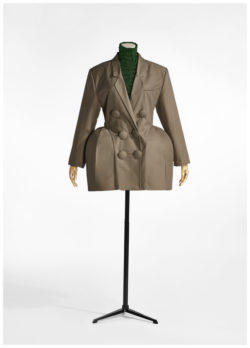Young Talent

The MoMu collection focuses on Belgian avant-garde fashion, but has in recent years gradually expanded to include non-Belgian, non-European, and non-Western fashion. In this way, the collection is enriched with other design practices and designers with different and innovative frames of reference.
Since the international breakthrough of the first generation of Belgian designers in the late 1980s, Belgian fashion and its international context have both seen radical change. Since then, the globalization of the fashion world has made the concept of ‘Belgian fashion’ far more complex. The origins of the designers, the places where they trained, the cultural, socio-economic and political contexts from which designers shape their oeuvres all lead to an identity that is constantly changing. ‘Belgian fashion’ has evolved into a quality label that has less to do with origins and more with the artistic vision and sensibilities of the designers. What unites them is a certain wilfulness, a conceptual approach, a love of surrealism and an unmistakable eye for detail.
MARINE SERRE

MOUTH AND MASKS
Even before the COVID-19 pandemic, Marine Serre integrated mouth masks into her collections, as a response to air pollution and the selfie phenomenon.

Following her studies at La Cambre and apprenticeships with Maison Margiela, Raf Simons and Balenciaga, Marine Serre launched her own label in Paris. Circularity and functionality are important core values in her work. She often begins with textiles that have already had previous lives, including silk, Scottish wool and jeans, as well as carpets and household textiles.
There is something poetic and magical about giving the past a new life. That transformation process is a crucial inspiration.
ESTER MANAS

In 2017, Ester Manas graduated from La Cambre with a one-size-fits-all collection. Working together with Balthazar Delepierre, she carries this concept through in the fashion label that bears her name. By offering clothing in a single size that fits everyone, she works towards a sustainable future: her pieces can continue to be worn as the body changes.
BOTTER


Romancing the Coral Reef
In 2020, in collaboration with a diving school in Curaçao, BOTTER set up a coral nursery to help regrow corals that are dying off. Twenty percent of their Autumn-Winter collection for 2021-22 was in fabrics made with ocean-borne plastic waste. They use the income from their designs to help pay for the coral nursery. The collection includes references to diving apparel and inventive dressmaking, as seen in this multifunctional waistcoat.

Rushemy Botter and Lisi Herrebrugh are the design duo behind the BOTTER label. She has Dominican roots, was born in Amsterdam and studied fashion at the Amsterdam Fashion Institute. He was born in Curaçao, grew up in the Netherlands and graduated in 2017 from the fashion department of the Royal Academy of Fine Arts in Antwerp. The Caribbean region plays an important emotional role in their design process, notably in the colours, the materials, the styling and the stories that they tell. Their education in the low countries in turn influences their love for history, conceptualization and research. Activism and a strong message are central to their collections.

BOTTER’s 2020-21 Autumn-Winter collection refers to Arte Povera, an art movement of the late 1960s that criticized power structures and the established order by, among other things, making use of unconventional materials. BOTTER poignantly translates this approach to today by, for example, adorning a jacket with plastic textile pins that would normally be used to attach price tags to articles of clothing.


After winning a number of prestigious fashion prizes, in the autumn of 2018, Lisi Herrebrugh and Rushemy Botter took over the creative direction for Nina Ricci. In a surprising leap to women’s fashion in their debut collection (Autumn-Winter 2019-20), they placed the emphasis on dressmaking and experimentation. They reproduced bubble wrap in organza, while seams in jackets took on the contours of swimwear. They left the French fashion house in 2022.
Minju Kim


After studying at the fashion department of the Royal Academy of Fine Arts in Antwerp, this Korean designer founded her own label in 2015. Her style bears witness to a fairytale-like imagination and playfulness, which she combines with attention to craftsmanship. Surprising volumes and a predelection jacquard and prints are a constant in her collections.
Photo above: Rushemy Botter en Lisi Herrebrugh for Nina Ricci, Spring-Suller 2020, Photo: Nadine Ijewere













